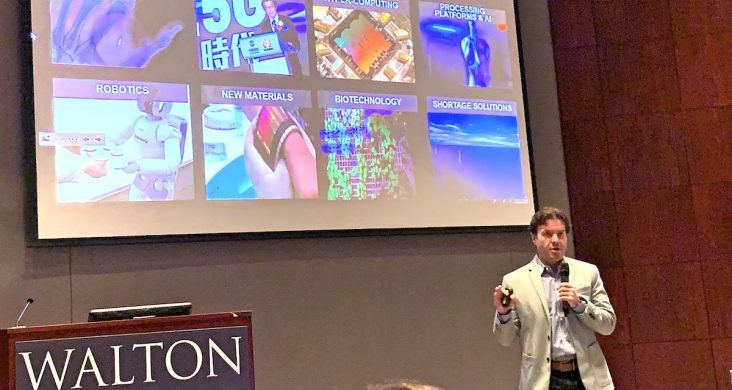Consumer obsession remains the focus of retailers and suppliers
by October 14, 2019 12:46 pm 1,342 views

Andres Meija, vice president of shopper marketing at Coca-Cola, was one of three keynote speakers at the main session of the Retailing Thought Leadership Conference held at the University of Arkansas.
Consumers are in the driver’s seat of the massive U.S. retail sector that’s worth $2.6 trillion and comprises roughly 16% of the nation’s GDP, according to panelists who spoke at the Retail Thought Leadership Conference held at the University of Arkansas on Friday (Oct. 11).
The two-day conference was hosted by the Sam M. Walton College of Business, was attended by academics from 30 universities around the world, and more than three dozen companies including Walmart, Dillard’s, Unilever and Coca Cola. Event organizers were Dr. Dinesh Gauri, UA marketing chair, Dr. Anne Roggeveen from Babson College in Boston, Dr. Dhruv Grewal from Babson College, and Dr. Raj Sethuraman from Southern Methodist University in Dallas.
The event focus was to provoke thought leadership around retail ecosystems. Walton College Dean Matt Waller shared how the region has grown into a retail valley, not unlike Silicon Valley is for technology. He said the region is ground zero for retail and supply chain. Waller said since he came to Fayetteville in 1994, the number of suppliers who have located offices in the region has grown from around 75 to more than 1,500. He said Walmart and K-Mart were about the same size in the early 1990s, but Walmart has succeeded in part because of its distribution system and willingness to adapt.
Cecilia Wu, vice president of customer science at Walmart, spoke about her nine-year study into shopper psychology. Wu said Walmart is focused on serving Millennial consumers because they are entering their big-spending years. The core customers of busy families are also a sweet spot for Walmart. Wu said by 2030 one in two children born in the U.S. will be multicultural. She said multicultural shoppers also tend to be digital enthusiasts, young and food-centric consumers who work to blend their cultures for their families.
Wu said there is bifurcation underway with consumers. She said overall the sentiment is rosy, but at the same time, they are seeing inflationary prices in healthcare, education, food and housing which could weigh on sentiment. Wu said Walmart will work to keep prices low and also reduce the friction points of shopping by leveraging technology. She said consumers are no longer willing to sacrifice time just to save money.
Andres Meija, vice president of shopper marketing at Coca-Cola, said the power has shifted from manufacturers and retailers to consumers. He said Coco-Cola continues to innovate products that serve the population where they live. He said as the population becomes more mobile that has resulted in a shift of product demands. He said a 64 ounce bottle of Coca Cola costs $1.68 at Walmart. A 20 ounce Coca-Cola product costs $1.88 at Walmart and outsells the larger size which offers value. Meija said the smaller size is sold cold and it fits consumers’ on-the-go need to drink it now.
Meija said product manufacturers have to rethink value and the meaning it has for busy consumers. He said as more people have breakfast on the go and engage in active lifestyles the demand for vitamin water and protein-infused drinks is rising. He said another trend consumers are obsessing over is “zero sugar.” Coca-Cola rebranded its diet soda drink – Coke Zero – to Coke Zero Sugar.
“People are serious about zero sugar. The very day we changed the branding of Coke Zero to reflect Zero Sugar, we saw a 30% lift in sales,” Meija said.
Jonathan Navallo, an executive at Walmart working in real estate, raised interesting ideas for retailers and the partnerships they are exploring. He said with nearly everything now available for purchase online, retailers have to work to make their stores experiential. He said Target and Kohl’s are doing a good job with this. Navallo said Kohl’s partnership with Amazon to accept the e-tailer’s returns was a clever way to draw those consumers into Kohl’s stores. Navallo said Kohl’s will give Amazon customers who make in-store returns a 25% coupon for a Kohl’s purchase. The program has helped improve Kohl’s’ sales and solved a problem as the biggest pain-point for buying online is the return process.
In an effort to boost beauty sales Walgreen’s partnered with Birchbox for a store within a store that has lifted the drugstore’s perception for beauty products in the eyes of consumers, Navallo said. He said Target has partnered with Disney for the store-within-a-store concept that has the ability to create a unique shopping experience.
Navallo said pop-up stores are another opportunity for retailers and the formats generate about $10 billion in annual sales. Lastly, Navallo said reverse logistics for product returns are also an opportunity for retailers. He said 75% of Amazon users would rather make returns in store which is part of the reason Amazon is looking at more brick and mortar stores.
Walmart allows the return of online orders at its stores. The primary reason is to provide convenience for the customer. Also, the retailer can ensure the product resale time is shortened.
